1301.04 Specimens of Use for Service Marks
37 C.F.R. 2.56
(a) An application under section 1(a) of the Act, an amendment to allege use under §2.76, a statement of use under §2.88, an affidavit or declaration of continued use or excusable nonuse under §2.160, or an affidavit or declaration of use or excusable nonuse under §7.36 must include one specimen per class showing the mark as actually used in commerce on or in connection with the goods or services identified. When requested by the Office as reasonably necessary to proper examination, additional specimens must be provided.![]()
(b)(2). A service mark specimen must show the mark as used in the sale of the services, including use in the performance or rendering of the services, or in the advertising of the services. The specimen must show a direct association between the mark and the services. ![]()
(c) A clear and legible photocopy, photograph, web page printout, or other similar type of reproduction of an actual specimen that meets the requirements of paragraphs (a) and (b) of this section is acceptable. The reproduction must show the entire specimen or enough of the specimen that the nature of the specimen, the mark, and the good or service with which the mark is used are identifiable. A web page must include the URL and access or print date. An artist's rendering, a printer's proof, a computer illustration, digital image, or similar mockup of how the mark may be displayed, or a photocopy of the drawing required by §2.51, are not proper specimens. ![]()
(d) The specimen must be submitted through TEAS in a file format designated as acceptable by the Office unless:![]()
(2) Submission on paper is permitted under § 2.23(c) or is accepted on petition pursuant to § 2.147.![]()
A service mark specimen must show the mark as actually used in the sale of the services, which includes use in the performance or rendering of the services, or in the advertising of the services recited in the application. 37 C.F.R. §2.56(b)(2). "[B]ecause by its very nature a service mark can be used in a wide variety of ways, the types of specimens which may be submitted as evidence of use are varied." In re Metriplex, Inc., 23 USPQ2d 1315, 1316 (TTAB 1992) . Whatever type of specimen is submitted, it must show proper use in commerce of the mark, which may be established by (1) showing the mark used or displayed as a service mark in the sale of the services, which includes use in the course of rendering or performing the services, or (2) showing the mark used or displayed in advertising the services, which encompasses marketing and promotional materials. See 37 C.F.R. §2.56(b)(2); On-Line Careline, Inc. v. Am. Online, Inc., 229 F.3d 1080, 1088, 56 USPQ2d 1471, 1476-77 (Fed. Cir. 2000) (indicating that an online menu item bearing the mark ONLINE TODAY was proper service mark use in connection with "providing access to online computer services offering computer-industry news, commentary and product reviews" because, inter alia, the "menu items are the mechanisms by which users obtained access to a particular online service"); In re Metriplex, Inc., 23 USPQ2d at 1316 (indicating that a specimen that does not explicitly refer to the services may be acceptable if it "show[s] use of the mark in the rendering, i.e., sale, of the services"); In re Red Robin Enters., 222 USPQ 911, 914 (TTAB 1984) (stating that "rendition" of services is properly viewed as an element of the "sale" of services). ![]()
The type of specimen submitted will often be apparent without the need for additional information regarding how the mark is used on the specimen. However, a specimen description submitted by the applicant typically helps clarify the manner in which the mark is used in commerce, and the more explanation the applicant provides initially, the more helpful it is to the examining attorney’s analysis. Thus, applicants are encouraged to provide a specimen description and explain how the applicant renders or provides the services and, if relevant, how marks are commonly used in the particular industry for such services. For instance, a description stating that a specimen comprises a title screen bearing the mark and showing the mark used in rendering the identified services is helpful for determining the nature and acceptability of the specimen.![]()
If it is not readily apparent that the specimen shows the mark as used in the sale or advertising of the services, and any specimen description does not provide adequate clarification, the specimen must be refused for failure to show use of the mark in commerce. See TMEP §1301.04(g) regarding the grounds for refusal. If further clarification regarding the nature of the specimen or the manner in which the mark is used may easily overcome the refusal (e.g., an explanation that the specimen is a title screen displaying the mark at the start of the provision of the identified services), an advisory to that effect may be included with the refusal. Under Trademark Rule 2.61(b), 37 C.F.R. §2.61(b), an examining attorney may also require the applicant to submit additional information about the specimen or the mark’s manner of use.![]()
Regardless of whether the specimen shows the mark used in the sale or advertising of the services, the examining attorney should consider the following when determining whether a service-mark specimen is acceptable. ![]()
1301.04(a) Whether the Specimen Shows the Mark as Actually Used in Commerce by the Applicant in the Sale or Advertising of the Services
The specimen must show the mark as actually used by the applicant in the sale or advertising of the services. 37 C.F.R. §2.56(b)(2). Acceptable specimens include newspaper and magazine advertisements, brochures, billboards, handbills, direct-mail leaflets, menus (for restaurants), press releases that are publicly available (e.g., on the applicant’s website), and the like. Business documents such as letterhead and invoices may be acceptable service-mark specimens if they show the mark and a direct association between the mark and the relevant services. Id.![]()
A clear and legible photocopy, photograph, web page printout, or other similar type of reproduction of an otherwise acceptable specimen is sufficient. See 37 C.F.R. §2.56(c). The reproduction must show the entire specimen or enough of the specimen that the nature of the specimen, the mark, and the service with which the mark is used are identifiable. Id. A web page submitted as a web page specimen must include the URL and access or print date. Id. See TMEP §1301.04(h)(iv)(C) regarding web page specimens for services. However, artist renderings, printer’s proofs, computer illustrations, digitally created images, or similar mock-ups of how the mark may be used, press releases sent exclusively to news media, or printed articles resulting from such releases are not acceptable because they do not demonstrate the required use of the mark by the applicant. See id.; TMEP §1301.04(f). See TMEP §904.04(a) regarding digitally created or altered or mockup specimens. In some instances, a specimen or the specimen description may indicate that a specimen is not yet in use in commerce by inclusion of wording such as "internal only," "printer’s proof," "website coming soon," or "under construction." ![]()
1301.04(b) Whether the Identified Services Are Registrable Services
A service-mark specimen must show the mark used or displayed in connection with a registrable service offered for the benefit of others. For information regarding activities that constitute registrable services, see TMEP §§1301.01–1301.01(b)(vi).![]()
1301.04(c) Whether the Specimen Shows Use in Connection with All Classes in a Multiple-Class Application
The same specimen may be acceptable for multiple classes if the specimen shows direct association between the mark and at least one of the identified services in each class. See 37 C.F.R. §2.56(b)(2); TMEP §1301.04(f)(ii). If the applicant intends for a submitted specimen to support multiple classes, the applicant should include a statement to that effect and indicate the classes supported by the specimen, but the applicant need not submit multiple copies of the same specimen. See TMEP §904.01(b).![]()
1301.04(d) Whether the Mark Is Used in Connection With the Identified Services
The specimen must demonstrate the mark serving as a source indicator for the identified services. Therefore, registration must be refused if the specimen shows the mark is used only to promote goods rather than the identified services, or the mark is not used as a service mark for the identified services, even if the specimen shows use of the mark as a service mark for other services (i.e., the applicant misidentified the services). See In re Weiss, Ser. No. 88621608, 2024 TTAB LEXIS 277, at *21 (2024) (applicant’s specimen was not acceptable because it showed use of the proposed mark for cooking and food-related products for sale by third parties on their websites and did not show use for the identified services, online retail store services); TMEP §§1301.02(a), 1301.02(e)–1301.02(f). See TMEP §1301.04(g)(i) regarding failure to show use in commerce and §1301.04(h)(iii) regarding misidentified services.![]()
1301.04(e) Whether the Mark Functions as a Service Mark
The proposed mark must actually function as a source-indicating service mark for the services identified in the application to be registrable. Thus, registration must be refused if, for example, the specimen shows the mark serves solely as a trade name (see TMEP §1202.01), only as the name of a downloadable or recorded computer software program or application (see TMEP §1301.02(f)), exclusively as the name of a method, process, or system (see TMEP §1301.02(e)), or merely as informational matter (see TMEP §§1202.04, 1301.02(a)). ![]()
The presence of the "TM" or "SM" symbol on the specimen cannot transform an unregistrable designation into a registrable mark. Univ. of Ky. v. 40-0, LLC, 2021 USPQ2d 253, at *32-33 (TTAB 2021) (citing In re Eagle Crest, Inc., 96 USPQ2d 1227, 1231 (TTAB 2010)); In re British Caledonian Airways Ltd., 218 USPQ 737, 739 (TTAB 1983); TMEP §1202.04. ![]()
See 37 C.F.R. §2.59 and TMEP §904.05 and §904.07–904.07(b)(i) regarding substitute specimens.![]()
1301.04(f) Elements of an Acceptable Service-Mark Specimen
To be acceptable, a service-mark specimen must show the mark sought to be registered used in a manner that demonstrates a direct association between the mark and the services. 37 C.F.R. §2.56(b)(2). Specimens need not explicitly refer to the services to establish the requisite direct association between the mark and the services, but "there must be something which creates in the mind of the purchaser an association between the mark and the service activity." In re Weiss, Ser. No. 88621608, 2024 TTAB LEXIS 277, at *12-13 (2024) (quoting In re Johnson Controls, Inc., Ser. No. 74195251, 1994 TTAB LEXIS 25, at *7 (1994)); In re Cardio Grp., LLC, 2019 USPQ2d 227232, at *1 (TTAB 2019) (quoting In re WAY Media, 118 USPQ2d 1697, 1698 (TTAB 2016)); see In re JobDiva, Inc.,843 F.3d 936, 942, 121 USPQ2d 1122, 1126 (Fed. Cir.2016) (quoting In re Ancor Holdings, LLC, 79 USPQ2d 1218, 1221 (TTAB 2006) ) ("[T]he question is whether the evidence of JobDiva's use of its marks ‘sufficiently creates in the minds of purchasers an association between the mark[s] and [JobDiva's personnel placement and recruitment] services.’").![]()
The acceptability of a specimen is determined based on the facts and evidence of record, and viewed in the context of the relevant commercial environment. See In re Ancor Holdings, LLC, 79 USPQ2d at 1220 ("[W]e must base our determination of public perception of applicant's mark on the manner of use of [the mark] in the advertising which has been submitted as a specimen. Further, we must make that determination within the current commercial context, and, in doing so, we may consider any other evidence of record ‘bearing on the question of what impact applicant's use is likely to have on purchasers and potential purchasers.’" (quoting In re Safariland Hunting Corp., 24 USPQ2d 1380, 1381 (TTAB 1992)). Thus, the information provided by the specimen itself, any explanations offered by the applicant clarifying the nature, content, or context of use of the specimen, and any other information in the record should be considered in the analysis. In re Cardio Grp., LLC, 2019 USPQ2d 227232, at *2 (citing In re Pitney Bowes, Inc., 125 USPQ2d 1417, 1420 (TTAB 2018); In re DSM Pharms., Inc., 87 USPQ2d 1623, 1626 (TTAB 2008) ("In determining whether a specimen is acceptable evidence of service mark use, we may consider applicant's explanations as to how the specimen is used, along with any other available evidence in the record that shows how the mark is actually used.")); see In re Weiss, 2024 TTAB LEXIS 277, at *8-10, *15-20 (applicant’s specimen for online retail store services showed a website with recommended cooking and food-related products where the "BUY NOW" button linked to third-party websites to purchase the product; applicant provided no evidence that consumers would perceive applicant as providing online retail store services on that website; and an "Amazon Associates" program showed participation in the program was to provide product recommendations or referral services and not retail services).![]()
When the identified services involve newer technology, the examining attorney must follow the appropriate examination policies and procedures, but also should employ a practical approach in analyzing the submitted specimen. See In re Ralph Mantia Inc., 54 USPQ2d 1284, 1286 (TTAB 2000) (finding a business card and stationery displaying the mark and the word "design" were acceptable specimens of use for applicant’s mark in connection with commercial art design services, noting that "[i]t is not necessary that the specific field of design, i.e., commercial art, also appear thereon" and that "the word ‘design’ alone is sufficient to create in the minds of purchasers an association between the mark and applicant's commercial art services"); In re Metriplex, Inc., 23 USPQ2d 1315, 1316 (TTAB 1992) (finding the submitted specimens acceptable to show use of applicant’s mark in connection with data transmission services because the specimens showed "the mark as it appears on a computer terminal in the course of applicant's rendering of the service" and noting that "purchasers and users of the service would recognize [applicant’s mark], as it appears on the computer screen specimens, as a mark identifying the data transmission services which are accessed via the computer terminal"). This may entail reviewing all the information of record to understand both how the mark is used and how it will be perceived by consumers. See In re JobDiva, 121 USPQ2d at 1126; In re Ancor Holdings, LLC, 79 USPQ2d at 1221. Additionally, if the examining attorney elects to conduct research regarding the mark, the services, or practices in the particular industry, it may be helpful to consider any information uncovered regarding how the applicant and others in the industry typically advertise and render the identified services in the relevant marketplace, as well as the manner in which service marks are normally used in connection with those services. See TMEP §1301.04(h)(iii) for a discussion of issues surrounding technology-related services.![]()
1301.04(f)(i) Show the Mark
The mark on the drawing must be a substantially exact representation of the mark shown on the specimen. See TMEP §§807.12–807.12(a)(iii) and §§807.12(d)–807.12(e) regarding agreement of the mark on the drawing and on the specimen. Furthermore, the designation must appear sufficiently prominent on the specimen (e.g., placement, size, or stylization) so that it will be perceived by consumers as a mark. See In re Dell Inc., 71 USPQ2d 1725, 1729 (TTAB 2004) (finding a mark "sufficiently prominent" even though it was "shown in a smaller type size than other words appearing on the webpage," given that it appeared "in a bullet listing of information about the product," and was placed "at the beginning of a line and [was] followed by the ‘TM’ trademark indicator"); TMEP §904.03(i)(B)(1). Compare In re Quantum Foods, Inc., 94 USPQ2d 1375, 1378 (TTAB 2010) (describing a mark as "prominently displayed" on the specimen when the mark appeared by itself above pictures relating to applicant’s goods in relatively large font and in a different color than some of the other text on the page) with In re Osterberg, 83 USPQ2d 1220, 1223 (TTAB 2007) (finding the mark not prominently displayed because it was buried in text describing the mark and, while the mark was shown in bold font, so was other matter). For instance, if shown in the same font, size, and color as the surrounding text on the specimen, the designation may not be perceived as a source indicator. See In re Osterberg, 83 USPQ2d at 1223. ![]()
1301.04(f)(ii) Direct Association Between the Mark and the Services
The specimen must show the mark used in a manner that creates in the minds of potential consumers a direct association between the mark and the services. 37 C.F.R. §2.56(b)(2); see generally In re JobDiva, Inc., 843 F.3d 936, 941 (Fed. Cir. 2016) (quoting In re Ancor Holdings, LLC, 79 USPQ2d 1218, 1221 (TTAB 2006)) ("[T]he question is whether the evidence of JobDiva's use of its marks ‘sufficiently creates in the minds of purchasers an association between the mark[s] and [JobDiva's personnel placement and recruitment] services.’"); In re Advert. & Mktg. Dev., Inc., 821 F.2d 614, 620 (Fed. Cir. 1987) ("The ‘direct association’ test does not create an additional or more stringent requirement for registration; it is implicit in the statutory definition of ‘a mark used * * * to identify and distinguish the services of one person * * * from the services of others and to indicate the source of the services.’"); In re Universal Oil Prods. Co., 476 F.2d 653, 655 (C.C.P.A. 1973) ("The minimum requirement is some direct association between the offer of services and the mark sought to be registered therefor."); In re Weiss, Ser. No. 88621608, 2024 TTAB LEXIS 277, at *7 (2024) (quoting In re DSM Pharms., Inc., 2008 TTAB LEXIS 29, at *3 (2008) ("A specimen that shows only the mark with no reference to, or association with, the services does not show service mark usage.")). ![]()
Direct association is the minimum the specimen must show, and it may be established textually, contextually, or logically. In re Universal Oil Prods. Co., 476 F.2d at 655, 177 USPQ at 457. What is necessary to establish direct association differs depending on the type of specimen submitted, that is, whether it is a specimen consisting of advertising or a specimen used in the rendering of the services.![]()
Mark Used in Sales or Advertising of Services: For specimens showing the mark used in advertising the identified services, to establish the requisite direct association the specimen must contain a reference to the services and the mark must be used on the specimen to identify the services and their source. In re Weiss, 2024 TTAB LEXIS 277, at *12 (quoting In re WAY Media, Inc., 118 USPQ2d 1697, 1698 (TTAB 2016)); In re Osmotica Holdings Corp., 95 USPQ2d 1666, 1668 (TTAB 2010) (finding that, although the specimens referenced the identified consulting services, the applied-for mark, as used on the specimens, would be perceived by the relevant public as identifying only applicant’s drug technology; the specimens failed to establish the required association between the mark and the identified services). While the services need not be stated word for word, a sufficient reference to the services themselves or a general reference to the trade, industry, or field of use is required. See In re Pitney Bowes, Inc., 125 USPQ2d 1417, 1419-20 (TTAB 2018) (reversing the specimen refusal since the wording "outsourced mailing services" appeared directly below the mark on the webpage advertising and was a sufficient reference to applicant’s mailing, shipping, and delivery services); In re Florists’ Transworld Delivery, Inc., 119 USPQ2d 1056, 1062-63 (TTAB 2016); In re Ralph Mantia Inc., 54 USPQ2d 1284, 1286 (TTAB 2000); see also TMEP §1301.04(h). However, if the alleged reference to the services is so vague that the services cannot be discerned, the specimen will not be acceptable. In re Chengdu AOBI Info. Tech. Co., 111 USPQ2d 2080, 2082 (TTAB 2011) ; see In re Monograms Am., Inc., 51 USPQ2d at 1318. See TMEP §1301.04(i) regarding examples of acceptable service-mark specimens.![]()
Mark Used in Rendering of Services: For specimens showing the mark used in rendering the identified services, the services need not be explicitly referenced to establish the requisite direct association. See In re Metriplex, Inc., 23 USPQ2d 1315, 1316-17 (TTAB 1992) (noting that "the requirements specific to specimens which are advertising are not applicable" and finding the submitted specimens acceptable to show use of applicant’s mark in connection with data transmission services because the specimens showed "the mark as it appears on a computer terminal in the course of applicant's rendering of the service" and noting that "purchasers and users of the service would recognize [applicant’s mark], as it appears on the computer screen specimens, as a mark identifying the data transmission services which are accessed via the computer terminal"). Rather, direct association may be indicated by the context or environment in which the services are rendered, or may be inferred based on the consumer’s general knowledge of how certain services are provided or from the consumer’s prior experience in receiving the services. Id.; see In re WAY Media, Inc., 118 USPQ2d at 1698 . In other words, the context in which the services are provided and consumer knowledge and experience create an inference of the services without an explicit textual reference to the services. See TMEP §1301.04(i), Example 17 (CASHFLOW UNITS).![]()
The applicant may respond to a specimen refusal for failing to show direct association by explaining the nature of the mark’s use or the manner in which the services are advertised or rendered. In re Metriplex, Inc., 23 USPQ2d at 1316 (specimens acceptable based, in part, on applicant’s explanation that the specimens showed the mark as it appeared on a computer terminal in the course of rendering the services). However, an applicant’s response must demonstrate that a consumer would perceive that the applicant is rendering or advertising the identified services. In re Weiss, 2024 TTAB LEXIS 277, at *18-21 (applicant’s explanation that it participated in an "Amazon Associates" program and operated an "Amazon affiliate store" through which applicant provided product recommendation or referral services and not the identified online retail store services did not demonstrate that consumers would perceive applicant as providing online retail store services on applicant’s website rather than referral services). With respect to a particular industry’s typical use of marks in relation to specific services, it may also be helpful for the applicant to provide an explanation regarding industry practice concerning the use of the mark during the rendering of such services and how the applicant’s use comports with such practice. See TMEP §1301.04(i), Example 19 (design of speech bubbles).![]()
The mere fact that the mark is displayed and the services are explicitly referenced or can be inferred from the context of the specimen does not automatically result in direct association between the mark and the services. See In re Johnson Controls, Inc., 33 USPQ2d 1318, 1320 (TTAB 1994). The specimen must associate the mark with the services such that the mark serves as a source identifier for those particular services. See In re WAY Media, Inc., 118 USPQ2d at 1698; cf. In re Sones, 590 F.3d 1282, 1288, 93 USPQ2d 1118, 1123 (Fed. Cir. 2009) ("[T]he test for an acceptable website-based specimen, just as any other specimen, is simply that it must in some way evince that the mark is ‘associated’ with the goods and serves as an indicator of source." (emphasis added)). The requisite direct mark-services association is present when the specimen makes a direct link or connection between the mark and the identified services. See TMEP §1301.04(i), Example 17 (CASHFLOW UNITS) and Example 18 (RIDE 411).![]()
Thus, a specimen is unacceptable if it fails to convey a proper nexus between the mark and the services, or if the services are too attenuated from the proposed mark, either in terms of proximity or logical connection. See, e.g., In re Monograms Am., Inc., 51 USPQ2d at 1319; In re Metriplex, Inc., 23 USPQ2d at 1316. The mere fact that wording from the identification of services appears somewhere on the specimen may not necessarily suffice for the mark-services association or nexus, if there is nothing else to connect that wording to the mark, such as proximity or additional text that establishes the connection.![]()
In assessing whether there is a direct association between the mark and services, the examining attorney should consider the specimen’s content, layout, and overall look and feel, as well as any description of the specimen and industry practice relating to service-mark usage in advertising and rendering the services.![]()
1301.04(g)(i) Failure to Show the Mark Used in Commerce
Trademark Act Sections 1 and 45, 15 U.S.C. §§1051, 1127, are the statutory bases for refusing a specimen that does not meet the requirements of an acceptable service-mark specimen; such specimen is not acceptable because it does not show the mark in "use in commerce." For instance, if the mark does not appear on the specimen or the specimen shows use of the mark in connection with goods rather than the identified services, the specimen must be refused for failure to show service-mark use in commerce in connection with the identified services.![]()
The applicant’s response options include submitting an acceptable substitute specimen or, if appropriate, amending the application to a §1(b) filing basis. See TMEP §806.03(c) regarding amending filing basis from §1(a) to §1(b), and §904.07 regarding requirements for substitute specimens. In some cases, the applicant may respond by providing clarification of the nature of the original specimen submitted, or an explanation of the content of the original specimen, to justify its acceptability.![]()
The examining attorney may consider any of the following facts and evidence properly made of record:
- declarations from persons with firsthand knowledge of the facts, with a sufficiently detailed explanation of how the mark is used in advertising or rendering the services or how the services are advertised or rendered;
- clarification of the specimen of record, such as an explanation of the nature, content, or context of use of the specimen (this explanation need not be verified with a declaration);
- evidence, such as declarations or industry-related periodicals, regarding industry practice with respect to how marks and services are promoted in advertising or how the services are rendered;
- additional background materials, such as printouts showing information on subsequent webpages from the applicant’s website or subsequent screenshots of an electronic device on which the services may be accessed, rendered, and experienced (this matter generally need not be verified with a declaration); and/or
- responses to any Trademark Rule 2.61(b) request for information.
If the specimen of record, the specimen description, the applicant’s response and explanations, and any additional proffered evidence are unpersuasive, a final refusal must issue, if the application is otherwise in condition for final. See 37 C.F.R. §2.63(b); TMEP §714.03.![]()
1301.04(g)(ii) Failure to Show the Mark Functioning as a Service Mark
A specimen may show the mark used as something other than a service mark for the identified services. For instance, it may show the mark used solely as a trade name, only as the name of a downloadable or recorded computer software program or application, exclusively as the name of a method, process, or system, or merely as informational or ornamental matter. See TMEP §§1202.01, 1202.03–1202.04, 1301.02(a), (e), (f). In such cases, the mark does not function as a service mark to identify and distinguish the applicant’s services and indicate their source. Thus, a failure-to-function refusal should issue under Trademark Act Sections 1, 2, 3, and 45 for marks seeking registration on the Principal Register. 15 U.S.C. §§1051─1053, 1127. For marks seeking registration on the Supplemental Register, the statutory basis for the failure-to-function refusal is Trademark Act Sections 23 and 45. 15 U.S.C. §§1091, 1127. However, if the mark identifies, for example, both a process and the identified services and the requisite mark-services association is present, no failure-to-function refusal should issue. See TMEP §§1301.02(e), 1301.04(j) (Example 21 (LEADING EDGE TONERS)). ![]()
As stated above, the issue of whether a designation functions as a mark usually is tied to the use of the mark, as evidenced by the specimen. Therefore, unless the drawing and description of the mark are dispositive of the failure to function without the need to consider a specimen, generally no refusal on this basis will be issued in an intent-to-use application under §1(b) of the Trademark Act, 15 U.S.C. §1051(b), until the applicant has submitted a specimen(s) with an allegation of use (i.e., either an amendment to allege use under 15 U.S.C. §1051(c) or a statement of use under 15 U.S.C. §1051(d)). However, in a §1(b) application for which no specimen has been submitted, if the examining attorney anticipates that a refusal will be made on the ground that the matter presented for registration does not function as a mark, the potential refusal should be brought to the applicant’s attention in the first Office action. This is done strictly as a courtesy. If information regarding this possible ground for refusal is not provided to the applicant before the allegation of use is filed, the USPTO is not precluded from refusing registration on this basis.![]()
In an application under §44 or §66(a), where a specimen of use is not required prior to registration, it is appropriate for the examining attorney to issue a failure-to-function refusal where the mark on its face, as shown on the drawing and described in the description, reflects a failure to function. See In re AC Webconnecting Holding B.V., 2020 USPQ2d 11048, at *7 (TTAB 2020) (holding an application for registration filed pursuant to §44(e) subject to the requirement that the applied-for mark function as a mark); In re Right-On Co., 87 USPQ2d 1152, 1156-57 (TTAB 2008) (noting the propriety of and affirming an ornamentation refusal in a §66(a) application).![]()
See TMEP §1202 regarding use of subject matter as a trademark; §§1302–1305 regarding use of subject matter as a collective mark; and §§1306–1306.06(c) regarding use of subject matter as a certification mark.![]()
1301.04(h)(i) Letterhead
Letterhead stationery, business cards, or invoices bearing the mark may be accepted if they create a direct association between the mark and the services. See 37 C.F.R. §2.56(b)(2). To create a direct association between the mark and services, the specimen does not have to spell out the specific nature or type of services; a general reference to the industry may be acceptable. In re Ralph Mantia Inc., 54 USPQ2d 1284 (TTAB 2000) (letterhead and business cards showing the word "Design" are acceptable evidence of use of mark for commercial art design services); In re Sw. Petro-Chem, Inc., 183 USPQ 371 (TTAB 1974) (use of mark on letterhead next to the name SOUTHWEST PETRO-CHEM, INC. found to be sufficient to show use of the mark for "consulting and advisory services relating to the making and using of lubricating oils and greases," when used for letters in correspondence with customers). ![]()
Letterhead or business cards that bear only the mark and a company name and address are not adequate specimens (unless the mark itself has a descriptive portion that refers to the service), because they do not show that the mark is used in the sale or advertising of the particular services recited in the application. In re Monograms Am., Inc., 51 USPQ2d 1317 (TTAB 1999) (letterhead specimen showing the mark MONOGRAMS AMERICA and the wording "A Nationwide Network of Embroidery Stores" held insufficient to support registration for consulting services for embroidery stores). ![]()
If the letterhead itself does not include a reference to the services, a copy of an actual letter on letterhead stationery bearing the mark is an acceptable specimen of use if the content of the letter indicates the field or service area in which the mark is used. In Monograms America, the Board indicated that the letterhead specimen might have been accepted if the applicant had submitted a copy of a letter to a store owner describing the services. 51 USPQ2d at 1319.![]()
1301.04(h)(ii) Specimens for Entertainment Services
For live entertainment services, acceptable specimens include a photograph of the group or individual in performance with the name displayed, e.g., the name printed on the drum of a band. For any entertainment service, advertisements or radio or television listings showing the mark may be submitted, but the specimen must show that the mark is used to identify and distinguish the services recited in the application, not just the performer. See In re Ames, 160 USPQ 214 (TTAB 1968) (advertisements for records show use of the mark for entertainment services rendered by a musical group, where the advertisements prominently feature a photograph of musical group and give the name, address, and telephone number of a booking agent).![]()
A designation that identifies only the performer is not registrable as a service mark. See TMEP §1301.02(b) regarding the registrability of names of characters or personal names as service marks, and §§1202.09(a)–1202.09(a)(iii) regarding the registrability of names and pseudonyms of performing artists. ![]()
1301.04(h)(iii) Specimens for Technology-Related Services
Proper specimen analysis requires consideration of the nature of the identified services. Modern computer and technology-related services present special challenges because these services, and the terminology used to describe them, are continually evolving. In addition, any online activity entails the use of computer software, making it difficult to differentiate the various services provided online from the underlying technology used to provide them. As the Board has noted, "[a]lthough it may well be software that is generating the [services], in today's commercial context if a customer goes to a company's website and accesses the company's software to conduct some type of business, the company may be rendering a service, even though the service utilizes software." In re Ancor Holdings, LLC, 79 USPQ2d 1218, 1221 (TTAB 2006) ; see also In re JobDiva, Inc., 843 F.3d. 936, 121 USPQ2d 1122 (Fed. Cir. 2016) . ("[I]f the software is hosted on JobDiva’s website such that the user perceives direct interaction with JobDiva during operation of the software, a user might well associate JobDiva's marks with personnel ‘placement and recruitment’ services performed by JobDiva"). ![]()
It may be unclear, based on the submitted specimen, whether the applicant is providing non-software services in a given field or subject matter (e.g., "financial retirement plan consulting services" in Class 36), or offering computer software or application services involving that same field or subject matter (e.g., "providing temporary use of on-line non-downloadable software for retirement planning" in Class 42), or both. Sometimes, an applicant that is actually providing on-line non-downloadable software services (e.g., "providing temporary use of on-line non-downloadable software for medical billing" in Class 42) misidentifies the services as the underlying function of the software (e.g., "medical billing" in Class 35). Similarly, the applicant may be using social networking websites to advertise non-social networking services (e.g., retail pet stores) and communicate with customers, leading the applicant to misidentify the services as "online social networking services" in Class 45.![]()
Thus, a primary consideration in these instances is whether the specimen indicates that the applicant is actually performing the relevant service activities for others, or, for instance, merely providing software that allows users of the software to perform those activities themselves, or only offering an online game that is accessed via a social networking website. See TMEP §1301.04(i), Example 5 (ATHENACOORDINATOR), Example 7 (CLINICANYWHERE), and Example 14 (OUTERNAUTS).![]()
Furthermore, some traditional services, and the associated terminology, may require fresh understanding and broader interpretation in the modern commercial environment. More and more traditional services are now offered online and, increasingly, multiple services are seamlessly integrated, creating difficulty in distinguishing the source of the services. For instance, television programs that were once provided only by broadcast television and cable outlets are now also accessible via streaming services like Netflix®, Hulu®, or YouTube®. Thus, typical service identification terms like "broadcasting," "distribution," and "transmission" have taken on new meaning in the modern marketplace. Thinking of traditional and other services more broadly and being cognizant of the current marketplace realities will also help the examining attorney determine whether the specimen properly shows use of the mark in direct association with the identified services.![]()
When the nature of the services is not readily apparent from the information of record, such as the identification and specimen, the examining attorney may consult several resources for research and guidance, including: the notices and notes in the U.S. Acceptable Identification of Goods and Services Manual (ID Manual); the applicant’s and third-party websites; technology dictionaries, encyclopedias, and trade and industry publications; and the Office of Trademark Classification Policy & Practice. Finally, the examining attorney may require the applicant to provide further information about the services, pursuant to Trademark Rule 2.61(b), 37 C.F.R. §2.61(b).![]()
1301.04(h)(iv) Common Forms of Specimens for Modern Technology-Related Services
As noted above, an applicant may submit a specimen that shows the mark as used in rendering the services. See 37 C.F.R. §2.56(b)(2). These specimens are often submitted in connection with modern technology-related services, and common types are discussed below.![]()
For specimens showing use of the mark in rendering the services, an explicit, textual reference to the services or their trade, industry, or field of use is not necessary, but an indication of the services sufficient to establish direct association between the mark and the services is required. The examining attorney must refuse the specimen if neither the specimen itself nor the description of the specimen provides sufficient information to decipher the nature of the services, determine the manner of use, and assess whether the necessary direct mark-services association exists. See TMEP §1301.04(g)(i).![]()
1301.04(h)(iv)(A) Sign-In Screens
Applicants often submit screenshots of sign-in screens as specimens for online services, such as non-downloadable software services and application-service-provider services. Sign-in screens show that the services are available and the context indicates that they are accessed by inputting credentials, which is a generally known and accepted means of accessing many online services. In re Metriplex, Inc., 23 USPQ2d 1315, 1317 (TTAB 1992) (finding the submitted specimens acceptable to show use of applicant’s mark in connection with data transmission services because "we have a situation where the service are rendered through the means of a tangible item, namely, a computer terminal, so that the mark can appear on the computer screen, and the specimens show such use").![]()
Some sign-in screens may include a reference to the services and effectively function as an advertisement. See TMEP §1301.04(i), Example 6 (MYFITAGE). Other sign-in screens may contain no reference to the services, but may nonetheless be acceptable if the overall content of the specimen sufficiently indicates the services. Or, the specimen description may explain the context of the services by stating the specimen is a sign-in screen for accessing the services and that applicant is offering the type of services being applied for. Such an explanation may provide a sufficient basis for accepting the sign-in screen specimen, as long as there is no contradictory information in the record indicating that the mark is not associated with the identified services. See TMEP §1301.04(i), Example 4 (STAFFTAP).![]()
1301.04(h)(iv)(B) Title or Launch Screens
A title or launch screen is an on-screen graphic typically displayed at the beginning of entertainment content, such as video games or ongoing television programs, often with other information about the content featured. For services such as Class 41 entertainment services involving the provision, production, or distribution of entertainment content, screenshots of title or launch screens from the content may create the requisite direct association between the mark and the services. Thus, title or launch screens may be acceptable specimens as long as their nature as such is clear either from the overall look and feel of the specimen or from the applicant’s description of the specimen.![]()
While showing the title or launch screen being displayed on any particular electronic device (e.g., television, computer, or smartphone) is not required, a specimen showing an electronic device bearing the title or launch screen may be acceptable without further explanation because it places the mark in the context of how the services are rendered. See TMEP §1301.04(i), Example 14 (OUTERNAUTS). A title or launch-screen specimen showing only the mark but not the electronic device, with no specimen description or an insufficient description, may require a specimen description identifying the specimen as a title or launch screen and placing the mark in the context of the services. See TMEP §1301.04(i), Example 13 (DELICIOSO).![]()
While title or launch-screen specimens may be acceptable to show service-mark use, the mark must be refused if the specimen shows that the mark is the title of a single creative work (e.g., the title or name of one episode of a television or radio program, one movie, or one show presented as a single event). See TMEP §§1202.08–1202.08(f) regarding titles of single creative works and §1301.02(d) regarding titles of radio and television programs.![]()
1301.04(h)(iv)(C) Web Pages
Web pages from an applicant’s or a third-party’s website may be submitted as advertising. This type of specimen is acceptable if it shows the mark used in advertising the identified services and creates the required direct association by referring to the services and by showing the mark being used to identify and distinguish the services and their source. See 37 C.F.R. §2.56(b)(2); In re Florists' Transworld Delivery, Inc., 119 USPQ2d 1056, 1062 (TTAB 2016). ![]()
Web pages lacking a reference to the services may be acceptable if they show use of the mark in rendering the services. See 37 C.F.R. §2.56(b)(2); TMEP §1301.04(i), Example 14 (OUTERNAUTS).![]()
Web pages from social-networking websites should be scrutinized to ensure that the mark is properly directly associated with the identified services. Some applicants may mistakenly mischaracterize their services as "social networking" because they assume that advertising or promoting their non-social-networking services via a social-networking website means they are providing social-networking services. For instance, an applicant may mistakenly file an application for "online social-networking services" and provide a Facebook® webpage as a specimen when, in fact, they operate a pet store and are only using the Facebook® website to advertise the pet store and communicate information to and messages with actual and potential customers. Such a specimen is not acceptable for the social-networking services since it does not demonstrate that the applicant is providing these services. See In re Florists' Transworld Delivery, Inc., 119 USPQ2d at 1057 ("[A]n applicant generally will not be able to rely on use of its social media account to support an application for registration of a mark for [the service of creating an online community for users].").![]()
URL and Date Accessed/Printed Required for Web Pages. Due to the transitory nature of Internet postings, the URL for the web page of the specimen and the date the page was accessed or printed must both be provided to enable verification. 37 C.F.R. §2.56(c). Trademark owners can submit the URL and date directly on the specimen webpage itself, appearing anywhere on the page within the trademark electronic filing system form that submits the specimen, or in a verified statement under 37 C.F.R. §2.20 or 28 U.S.C. §1746 in a later-filed response. This information may not be entered via examiner’s amendment. In rare situations, if the web page includes a photograph of the applied-for mark that directly associates the mark with the identified services (e.g., a picture showing a mark for restaurant services on a restaurant building) and that would otherwise be acceptable as a specimen of use for services, it need not include the URL and access or print date.![]()
Specimens in applications and post-registration filings submitted prior to February 15, 2020 are "grandfathered" under the prior rules, until the application registers or is abandoned and cannot be revived or reinstated pursuant to 37 C.F.R. §§2.64, 2.66, or 2.146, or until the acceptance or final rejection of the post-registration filing. Specimens and substitute specimens submitted on or after February 15, 2020, including those submitted in connection with applications and post-registration filings that were filed prior to February 15, 2020, are not grandfathered and must comply with the current specimen rules.![]()
1301.04(h)(iv)(D) Services Rendered by Means of Software Applications (Apps)
Software applications (apps) for smartphones and computer tablets are now commonly used to provide online services. Apps are simply the interface that enables the providers of the services to reach the users and render the services, and the users to access those services. Common specimens for services rendered by means of such apps are usually screenshots of electronic devices showing the apps rendering the services. Such a specimen will not always depict proper service-mark use of the mark in connection with the identified services unless the displayed screenshot clearly and legibly shows the mark directly associated with the identified services as the services are rendered or performed via the app. Mere depiction of the mark in the screenshot without sufficient depiction of the activity identified in the services does not establish service mark use within the definition of "use in commerce" under Trademark Act Section 45. 15 U.S.C. §1127 ("For purposes of this chapter, a mark shall be deemed to be in use in commerce – (2) on services when it is used or displayed in the sale or advertising of services and the services are rendered in commerce[.]") See TMEP §1301.04(i), Example 15 (KURBKARMA).![]()
1301.04(i) Examples of Acceptable Service-mark Specimens
The following examples in this section would only be accepted by the USPTO if they included the required URL and date accessed or printed. See 37 C.F.R. §2.56(c).![]()
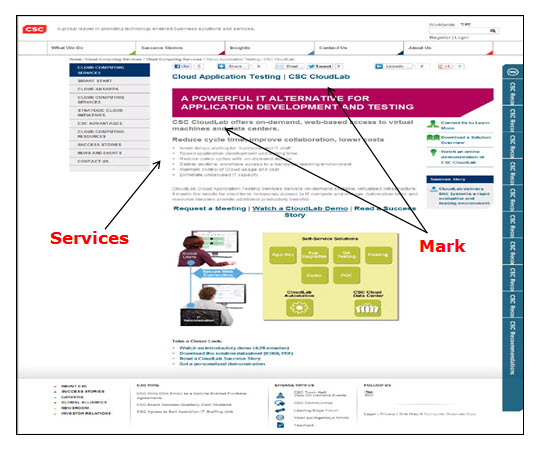
Relevant Services: Infrastructure as a Service (IAAS) services, namely, providing web-based use of virtualized computer hardware, networking, and storage equipment on a utility computing basis, namely, providing virtual computer systems and virtual computer environments through cloud computing, in Class 42.![]()
- Specimen is described as "web page screenshot" and appears to be advertising.
- Mark is displayed near the top center of the webpage in large, color font, and in the middle center of the webpage at the beginning of a statement shown in bold font.
- Services are referenced in the following statements:
- "CSC CloudLab offers on-demand, web-based access to virtual machines and data centers."
- "CloudLab Cloud Application Testing Services delivers on-demand scalable, virtualized infrastructure."
- Direct mark-services association is present because the mark is used directly in connection with the services in textual statements describing the services, and is placed immediately above explicit/textual references to the services.
.jpg)
.jpg)
Services: Platform as a service (PAAS) featuring computer software platforms offering server-side functionality to provide backend services, namely, data storage, push notifications and user management, all for mobile applications, in Class 42.![]()
- Original specimen is described as "website offering purchase and download of Parse software"; the substitute specimen is described as "website advertising."
- On the substitute specimen, the mark is presented in large font on the top of the webpage and on the screen of an electronic device.
- Original specimen was refused because the specimen and its description indicated the mark is used in association with software goods rather than PAAS services.
- Substitute specimen is acceptable due to the following statements referencing the services and the following indicia of the context in which the services are rendered:
- The wording "The mobile app platform for developers" and "Add a powerful and scalable backend in minutes for your Marketing App" describes the nature of the services.
- The "Manage your apps" button indicating that the services are accessed by clicking on the button.
- Direct mark-services association is present because it is customary to display service marks near the top of the webpages on which the services are advertised or through which they are accessed, rendered, and experienced. Here, the mark is in close proximity to explicit textual references to the services and the "Manage your apps" button, thus creating the mark-services connection.
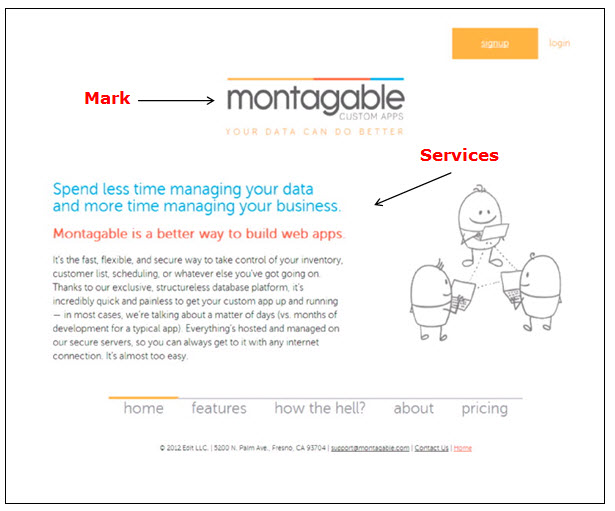
Services: Computer software platform as a service (PAAS) featuring computer software platforms for application building, in Class 42.![]()
- Specimen is described as "screenshots" from applicant’s website and appears to be advertising.
- Mark is prominently shown in large font on the top of the webpage.
- Services are referenced in the following statements:
- "Montagable is a better way to build web apps."
- "Thanks to our exclusive, structureless database platform, it’s incredibly quick and painless to get your custom app up and running . . . ."
- "Everything’s hosted and managed on our secure services, so you can always get to it with any internet connection."
- Direct mark-services association is present because the mark is used directly in connection with the services in textual statements describing the services, and is placed immediately above explicit textual references to the services as well as in statements referencing the services.
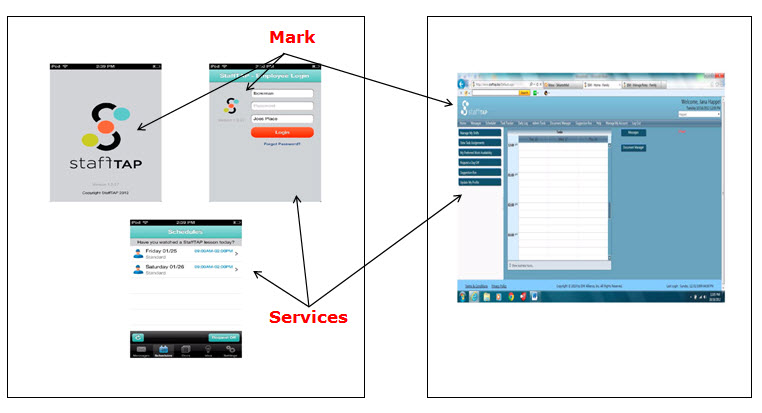
Services: Software as a service (SAAS) services featuring software for use in staff management and related scheduling tasks, in Class 42.![]()
Analysis:
- Specimen is described as "screenshot capture of a representative online portal" and appears to show the mark used in rendering the services.
- Mark appears prominently in large font on a launch screen, on the sign-in screen, and on the top of a screen displaying the software services in use.
- Services are indicated by the context in which they are rendered, as follows:
- A launch screen with the wording "Version 1.0.27" indicates the version of the online software services being rendered.
- The "Employee Login" screen indicates that one must log in to access the software services and the subsequent screen shows the schedule for Friday and Saturday.
- A screen showing a date and time grid for scheduling tasks and the menu on the left containing options, including "Manage My Shifts" and "View Task Assignments," indicates the staff management functions of the software services.
- Direct mark-services association is present because the mark appears on the launch screen where it is customary in such industry to place the mark under which the services are offered and such placement is recognized as the introduction of the online services; and the mark also appears on the sign-in screen where it is customary to input credentials to gain access to online services. The context in which the mark is used, i.e., on the title and sign-in screens, creates the mark-services connection (since using such screens is common practice for rendering such services) and implies that the services are available and rendered once the user initiates access to the services by logging in. The launch screen alone is acceptable because it is generally known that such screens are used to initiate the start up of or access to online services. The sign-in screen is also acceptable on its own since it is a generally known means of accessing online services. The mark is also displayed on another screen which shows the mark while the services are being performed and, thus, the proximity of the mark to the services conveys a connection.
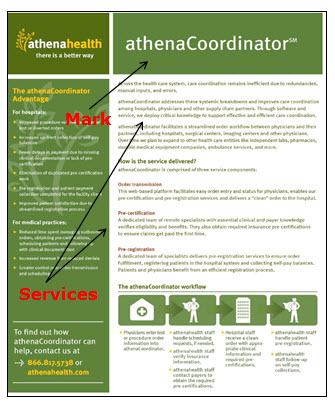
Services: Physician order support services and medical practice management services relating to medical tests and procedures, namely, verifying patient eligibility and benefits, handling scheduling requests, obtaining insurance pre-certifications, handling patient pre-registrations, and collecting self-pay balances from patients, in Class 35; and Software as a service (SAAS) services featuring software for use in communications between physicians and other participants in the health care system with respect to orders for medical tests and procedures, in Class 42. ![]()
Analysis:
- Specimen is described as a "brochure" and appears to be advertising.
- Mark appears prominently in large font on the top of the brochure.
- Class 35 services are referenced in the following statements:
- "Through software and service, we deploy critical knowledge to support effective and efficient care coordination."
- "A dedicated team of remote specialists with essential clinical and payer knowledge verifies eligibility and benefits. They also obtain required insurance pre-certifications to ensure claims get paid the first time."
- "A dedicated team of specialists delivers pre-registration services to ensure order fulfillment, registering patients in the hospital system and collecting self-pay balances. Patients and physicians benefit from an efficient registration process."
- Class 42 services are referenced in the following statements:
- "Through software and service, we deploy critical knowledge to support effective and efficient care coordination."
- "The web-based platform facilitates easy order entry and status for physician, enables our pre-certification and pre-registration services and delivers a "clean" order to the hospital."
- Direct mark-services association is present because the mark is used directly in connection with the services in textual statements describing the services, and is placed immediately above explicit textual references to the services.
Non-Downloadable Software Services ![]()
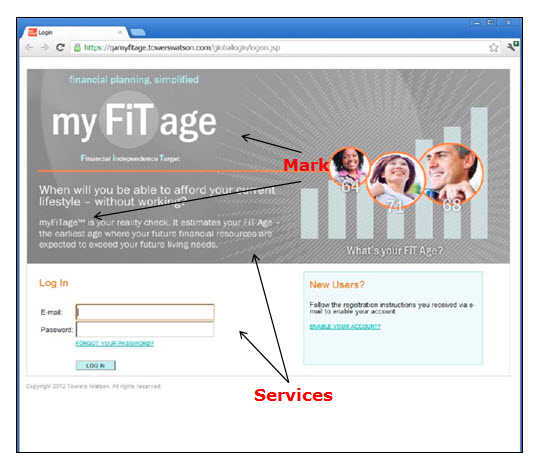
Services: Providing temporary use of non-downloadable computer software for retirement planning, in Class 42.![]()
Analysis:
- Specimen is described as "web printout" and appears to show the mark used in rendering the services.
- Mark is shown in large font at the top of the webpage and in the middle of the webpage.
- Services are referenced in the following statements and indicated by the context in which they are rendered, as follows:
- The wording "financial planning simplified" appears above the mark.
- The wording "Financial Independence Target" appears below the mark.
- "myFiTage is your reality check. It estimates your FiT Age – the earliest age where your future financial resources are expected to exceed your future living needs."
- "Log in" fields are provided for accessing the non-downloadable software.
- Direct mark-services association is present because the mark appears on the sign-in screen where it is customary in such industry to input credentials to gain access to online services. The context in which the mark is used, i.e., during the sign-in process, creates the connection with the services since sign-in screens are common practice and imply that the services are available and rendered once the user logs in. Additionally, the mark is used directly in connection with the services in textual statements describing the services, and is placed above and below statements referencing the services, further conveying the direct mark-services connection. The sign-in screen alone would also be acceptable even if the services were not textually referenced since it is a generally known means of accessing online services. The specimen is acceptable both as an advertisement and as showing the mark in rendering the services.
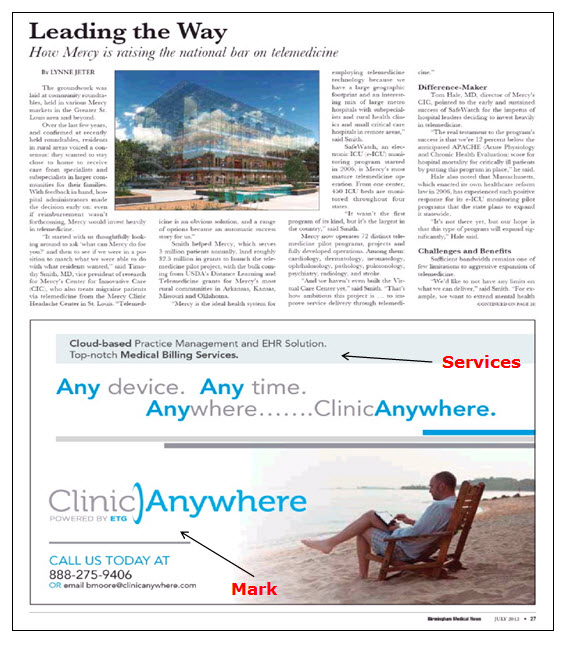

Services: Medical Billing Support, in Class 35; and Providing on-line, non-downloadable, Internet-based software application for medical billing for physicians and health care institutions, in Class 42. ![]()
Analysis:
- Specimen is described as an advertisement.
- Mark is prominently displayed in large, color font in the middle of the advertisement.
- Class 35 services are referenced in the following statement:
- "Top-notch Medical Billing Services."
- Class 42 services are referenced in the following statements:
- "Cloud-based Practice Management and EHR Solutions."
- "Any device. Any time. Anywhere.......ClinicAnywhere."
- Direct mark-services association is present because the mark is used directly in connection with the services in textual statements describing the services, and is placed immediately below explicit textual references to the services.
Application-Service-Provider (ASP) Services ![]()

Services: Application service provider (ASP), namely, hosting computer software applications for others in the field of ticketing and related ticketing services, in Class 42.![]()
Analysis:
- Specimen is described as a "screen shot" and appears to show the mark used in rendering the services.
- Mark is prominently displayed on the bottom of the screenshot.
- Services are indicated by the context in which they are rendered, as follows:
- The mark is displayed directly below the area where customers purchase tickets, thereby indicating that the ASP hosting or providing the software services is INSITE TICKETING.
- The wording "Technology by" placed next to the mark, implies that the software technology services that are operating the website are provided by the applicant.
- Direct mark-services association is present because the mark is displayed on the screen where the services are rendered and experienced. While another mark, "Ticket Central," is shown on the top left of the webpage, it appears to be associated only with ticket-purchasing services, not ASP services, and thus does not detract from associating the applied-for mark with the identified services.
.jpg)
.jpg)
Services: Providing on-line forums for transmission of messages among computer users, in Class 38.![]()
Analysis:
- Original specimen is described as "website screen-shot" and the substitute specimen is described as "screenshot of the homepage of the website."
- Mark is presented on the substitute specimen at the top right of the webpage.
- Original specimen was refused because it failed to reference the services.
- Substitute specimen is acceptable because the services are indicated by the following:
- "Sign in to GovHub" indicates that a user may log in to use the services, i.e., read and send messages.
- "Top Discussions" shows two discussion topics in progress, and the "5" and "0" shown in the color blue specify that there are 5 messages posted for the first discussion and 0 for the second discussion, indicating that the services involve on-line forums for transmission of messages.
- Direct mark-services association is present on the substitute specimen because it is customary to display service marks near the top of the webpage on which the services are advertised or through which they are accessed, rendered, and experienced. Here, the mark is in proximity to indicia implying the services and no other marks appear to negate the mark-services connection. While the services are not explicitly textually referenced, when viewing the heading "Top Discussions," the two discussion topics below it, and the "5" and "0" messages posted about the discussion topics – all these factors together indicate that applicant is offering online forum services.

Services: Electronic transmission and streaming of digital media content for others via global and local computer networks; Streaming of audio material on the Internet; Transmission services via the Internet, featuring MP3 files and music videos, in Class 38.![]()
Analysis:
- Specimen is described as "website for Hometown Sounds" and appears to show the mark used in rendering the services.
- Mark is presented in large font on the top of the webpage.
- Services are referenced in the following statements and indicated by the context in which they are rendered, as follows:
- The wording "DC’s local music internet station" describes the services.
- The wording "Listen Now" indicates that the website may be used to stream audio content.
- The link "Click Here to listen to Hometown Sounds" indicates that the services are accessed by clicking on the link.
- Direct mark-services association is present because it is customary to display service marks near the top of the webpage on which the services are advertised or through which they are accessed, rendered, and experienced. Here, the mark is physically close to indicia implying the services and no other marks appear to negate the mark-services connection. The mark appears above textual references to the services as well as in textual instructions for accessing the services, which further conveys the mark-services connection. The specimen is acceptable both as an advertisement and as showing the mark in rendering the services.
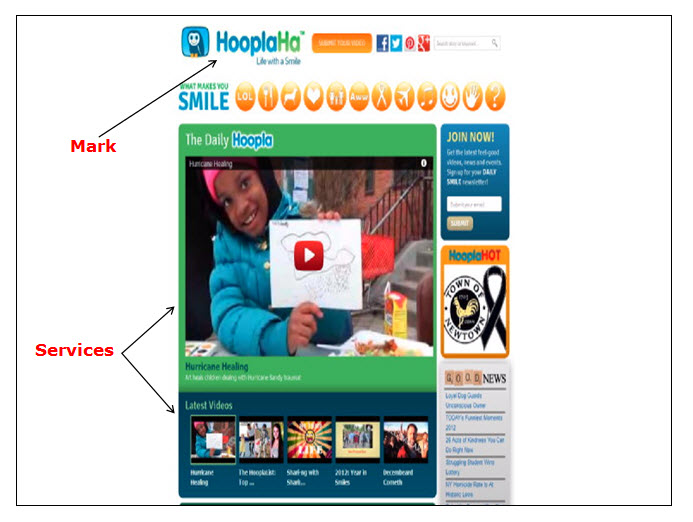

Services: Broadcasting of video and audio programming over the Internet, in Class 38.![]()
Analysis:
- Specimen is described as "web page" and appears to show the mark used in rendering the services.
- Mark is shown in large font on the top of the webpage.
- Services are indicated by the following:
- A freeze-frame of a video featuring a play button is displayed, indicating the services are accessed by clicking the play button.
- The wording "Join Now! Get the latest feel-good videos, news and events" conveys the different content that is available for broadcast.
- The wording "Latest Videos" and the images of several videos appear near the bottom, implying that other videos are available for broadcast.
- Direct mark-services association is present because it is customary to display service marks near the top of the webpages on which the services are advertised or through which they are accessed, rendered, and experienced. Here, the mark is sufficiently near indicia implying the services and no other marks appear to negate the mark-services connection. While the nature of the services is not explicitly textually referenced, the display of the play button and "Latest Videos" indicate that applicant is offering broadcasting services.
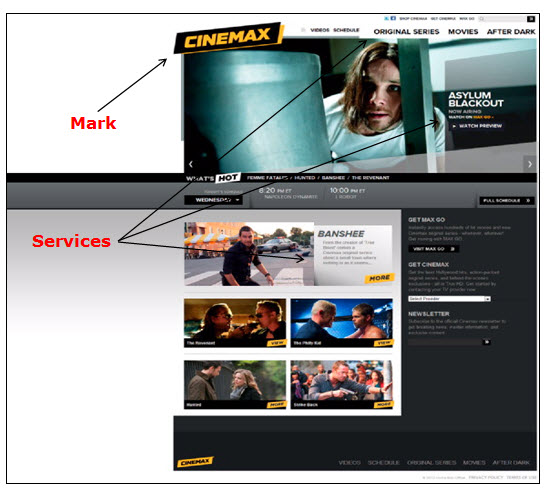
Services: Entertainment services in the nature of providing entertainment programming and content, namely, on-going television programs, and related clips and graphics and information relating to television programming and content in the fields of comedy, drama, action, adventure via television, cable and satellite systems, the Internet, electronic communications networks, computer networks and wireless communications networks, in Class 41.![]()
Analysis:
- Specimen is described as "mark as used in commerce on specified goods and services" and appears to be a webpage advertising some of the identified services and rendering other identified services.
- Mark is displayed prominently at the top of the webpage.
- Services are referenced in the following wording and statements:
- The navigation tabs at the top "VIDEOS," "SCHEDULE," "ORIGINAL SERIES," "MOVIES," and "AFTER DARK" indicate the entertainment content available.
- The play button next to "WATCH PREVIEW" indicates that a clip of the show "ASYLUM BLACKOUT" may be viewed.
- The reference to "BANSHEE" states "From the creator of ‘True Blood’ comes a Cinemax original series about a small town where nothing is as it seems . . .," advertising another on-going television program.
- Direct mark-services association is present because it is customary to display service marks near the top of the webpage on which the services are advertised or through which they are accessed, rendered, and experienced. Here, the mark is sufficiently near textual references to the services, thus indicating the direct mark-services connection.
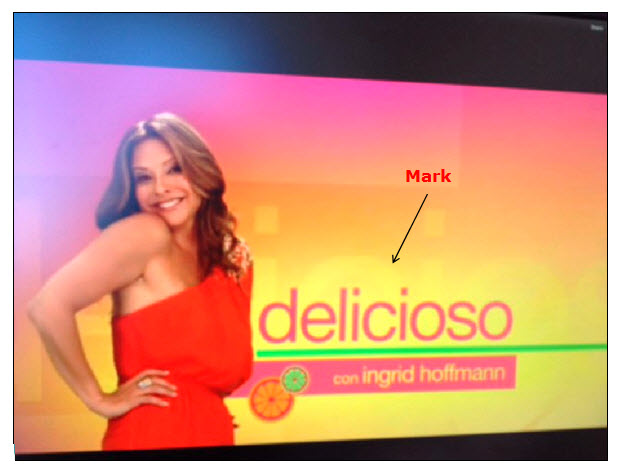
Services: Entertainment and education services, namely, ongoing television program concerning cooking and nutrition, in Class 41.![]()
Analysis:
- Specimen is described as a "photo of opening title of applicant's television program" and appears to show the mark used in rendering the services.
- Mark is prominently shown in large font on the title screen of an electronic device that is displaying the ongoing television program.
- Direct mark-services association is present because the mark appears on the title screen where it is customary in such industry to place the mark under which the services are promoted. It is common practice for a title screen bearing the mark to appear at the start of entertainment content and indicate the launch of the services. While the nature of the services is not textually referenced, it is sufficient that the overall content of the specimen implies that applicant is offering entertainment services.
- The specimen would be unacceptable without the specimen description, which clarifies that the specimen is an "opening title" and places the mark in the context of providing the services. Since the specimen could possibly be print advertising, a specimen description is necessary to clarify the nature of the specimen. The top right corner of the specimen shows some wording that suggests that the title screen is displayed on an electronic device. However, since that wording is not legible and the context of the title screen is not visible, the nature of the specimen is unclear and, thus, a specimen description is required clarifying that it is a title screen.
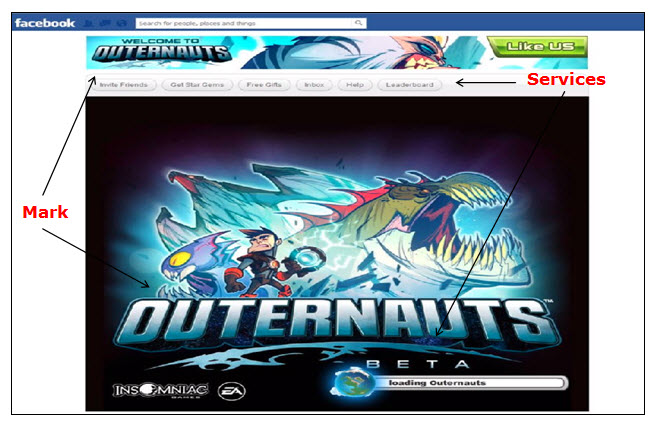
Services: Entertainment services, namely, providing online video games, in Class 41.![]()
Analysis:
- Specimen is described as a "screenshot of the page on Facebook.com, an Internet website, from which the services are provided to users" and appears to show the mark used in rendering the services.
- Mark is prominently shown in large font near the top of the webpage.
- Services are referenced in the following statements and indicated by the following:
- The mark appears near video game information "Get Star Gems," "Leaderboard," and "loading Outernauts."
- The mark appears near the word "Games," generally referencing the services.
- Direct mark-services association is present because it is customary to display service marks near the top of the webpage on which the services are advertised or through which they are accessed, rendered, and experienced. Here, the mark is near indicia implying the services and other marks appear to cloud the mark-services connection. While the specimen shows the webpage is from a third-party website, i.e., Facebook®, this does not diminish the requisite direct association due to the proximity of the applied-for mark to the matter indicating the online services, which appear to be directly launched from the website. The screenshot also appears to be of the title or launch screen of the online video game, where it is common practice in such industry to place the mark under which the services are promoted and where such placement is recognized as the introduction of the online services. The screenshot here implies, and it is generally known, that access to and performance of the services begins with this screen. The specimen description combined with the wording "loading Outernauts" further supports the direct mark-services connection. The specimen is also acceptable as an advertisement since the word "Games" appears on the lower left corner as part of a third-party mark "Insomniac Games." It may be inferred that the combination of the applied-for mark OUTERNAUTS with the reference to "Games" and to "EA" sufficiently and textually references the online video game services.
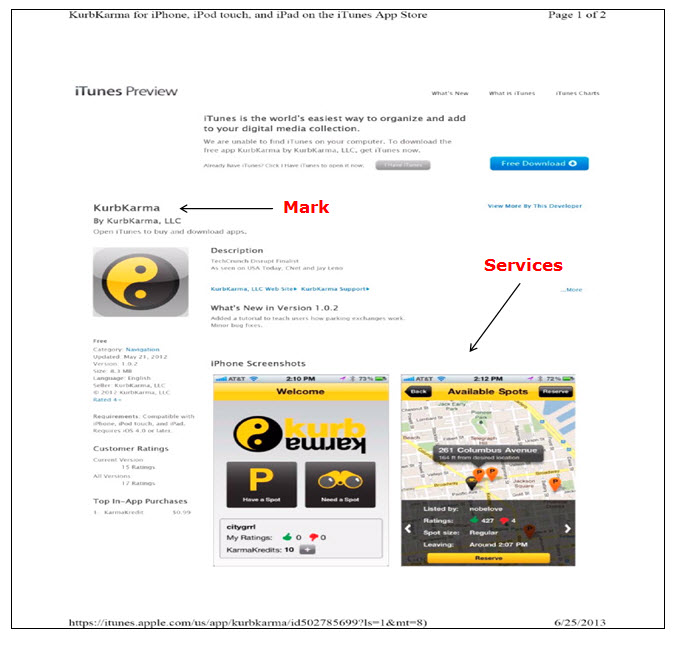
Services: On-line matching services for connecting automobile drivers with other drivers who are, respectively, searching for or departing from parking spaces accessible via a mobile application, in Class 35.![]()
Analysis:
- Specimen is described as "screenshot of the ITunes store which features Applicant's mark and describes Applicant's services."
- Mark is displayed in bold font in the middle left of the webpage.
- Services are indicated by the following:
- The iPhone® screen images clearly and legibly show the wording "Have a Spot," "Need a Spot," and "Available Spots," indicating the services being performed by the applicant via the app.
- Direct mark-services association is present because the mark is placed in sufficiently close proximity to the iPhone® screenshots, which show the services as they are accessed and rendered via the device.
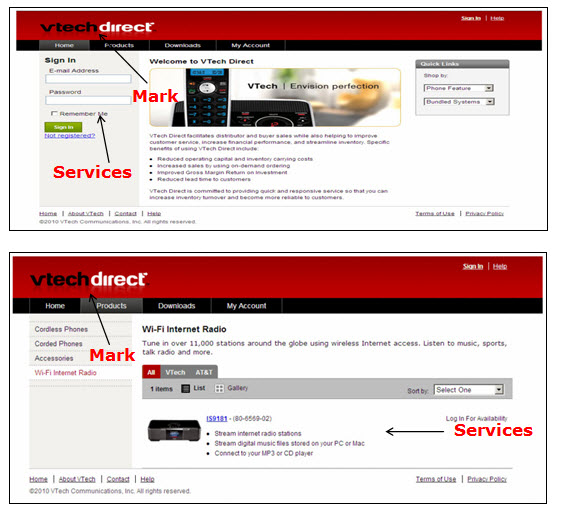
Services: Providing a web site for online business-to-business store services featuring wireline telephony products and wireless fidelity streaming music devices; online business-to-business store featuring wireline telephony products and wireless fidelity streaming music devices, in Class 35.![]()
Analysis:
- Specimen is described as "pages from website" and appears to show the mark being used in both the advertising and rendering of the services.
- Mark is displayed prominently in bold font on the top left of each webpage.
- Services are referenced and indicated by the following:
- "Sign In" fields are provided for accessing the online business-to-business store services, indicating that one may access the services by logging in.
- "Tune in over 11,000 stations around the globe using wireless Internet access. Listen to music, sports, talk radio and more."
- Image of an electronic streaming music device described as "IS9181 – (80-6569-02) Stream internet radio stations Stream digital music files stored on your PC or Mac Connect to your MP3 or CD player."
- Direct mark-services association is present because it is customary to display service marks near the top of the webpage on which the services are advertised or through which they are accessed, rendered, and experienced. Here, the mark is near explicit textual references to the services, thus conveying the direct mark-services connection. The webpage showing the sign-in fields is an acceptable specimen since signing-in is a generally known means of accessing online services. Thus, the specimen is acceptable both as an advertisement and as showing the mark in rendering the services.
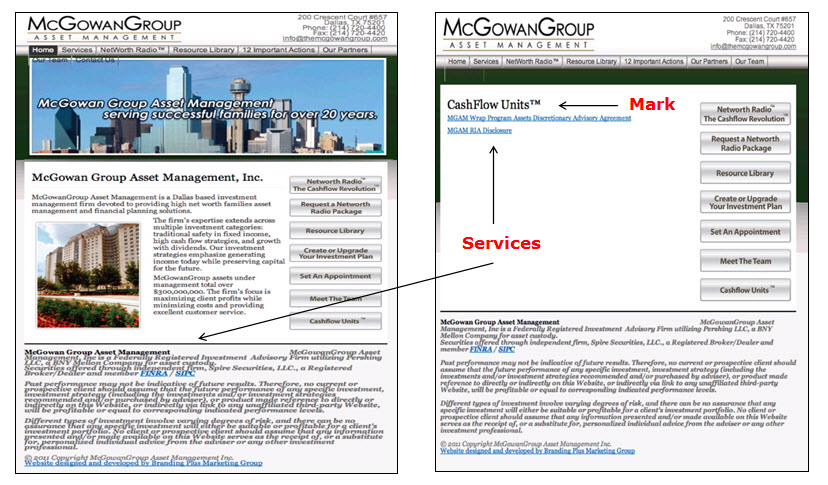
Services: Investment products, namely, wealth management and performance tracking, and providing financial advisory and financial portfolio management services, in Class 36.![]()
Analysis:
- Specimens are described as "webpages."
- Mark is placed below "the McGowanGroup Asset Management banner."
- The Board held the specimen acceptable as showing use of the mark in rendering the services based on the following findings:
- "The disclosures at the bottom of one webpage inform the viewer that applicant is a ‘Federally Registered Investment Advisory Firm.’"
- The mark "appears under the McGowanGroup Asset Management banner, thus informing the viewer that CASHFLOW UNITS are part of an asset management service."
- Directly below the mark are links to two documents: (1) the "MGAM Wrap Program Assets Discretionary Advisory Agreement"; and (2) the "MGAM RIA Disclosure". The Board noted that the first document is the applicant’s contract and an offer to enter into an agreement for advisory services, and the second document is the applicant’s notice of compliance with the conflict of interest rules.
- The mark on the webpage is placed "in close proximity to links for documents used by applicant in rendering those services" and "the links to these documents create an association between the mark and the offered service activity."
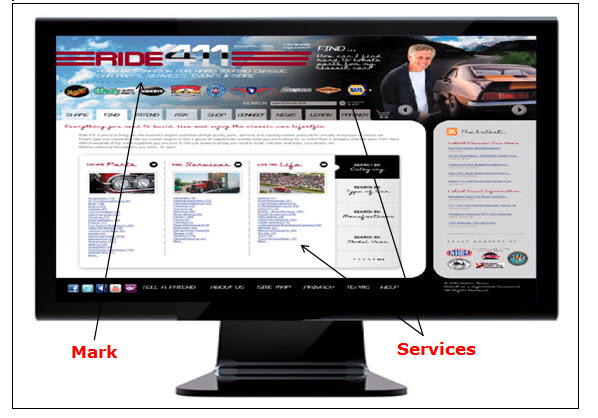
Relevant Services: Providing an online search engine service for new and used automobile listings and automobile related information; Providing specific information as requested by customers via the Internet; Provision of Internet search engines; Provision of search engines for the Internet, in Class 42.![]()
Analysis:
- Specimen is described as "screen shot of our website" and appears to be a webpage advertising some of the identified services and rendering other identified services.
- Mark is displayed in large, color font on the top of the webpage.
- Services are referenced in the following statements and indicated by the context in which they are rendered, as follows:
- "Simply type any keyword(s) into our search engine to find a group of suppliers for exactly what you are looking for, or select from a category and drill down from there."
- The wording "Your destination for hard to find classic car parts, services, events & more" and "FIND ... How can I find hard to locate parts for my classic car?" indicates the nature of the services provided.
- Hyperlinks appear under "Locate Parts," "Locate Services," and "Search By Category."
- Services are provided primarily for the benefit of others, i.e., the users are able to view the search results from a variety of sources from the Internet in one list.
- Direct mark-services association is present because it is customary to display service marks near the top of the webpage on which the services are advertised or through which they are accessed, rendered, and experienced. Here, the mark is near textual references to the services, thus indicating the mark-services connection. The mark is also near indicia of the services, i.e., searchable links and categories for locating automobile parts and services, which is also sufficient to show a direct mark-services association. Thus, the specimen is acceptable both as an advertisement and as showing the mark in rendering the services.
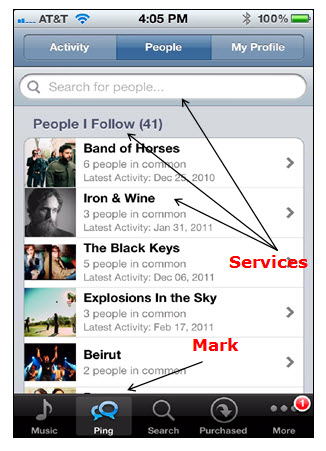
Mark: (stylized speech bubbles)![]()

Services: Online social networking services, in Class 45.![]()
Analysis:
- Specimen is described as "screenshot of applicant’s software" and appears to show the mark used in rendering the services.
- Mark is displayed in the color blue at the bottom of the screen of an electronic device.
- Services are indicated by the following:
- A highlighted "People" tab appears at the top of the screen, as does a search bar containing the wording "Search for people."
- The wording "People I Follow (41)" indicates that the user follows 41 people and the screen shows a list of people being followed, each specifying the number of "people in common."
- Applicant explained that the specimen is a screenshot from an Apple® handheld mobile device showing the mark used in rendering the services.
- Direct mark-services association is present because the mark appears on the screen of an electronic device via which the online services are accessed, rendered, and experienced. Additionally, the mark is displayed on the screen below indicia implying the services as well as showing the services as they are accessed and rendered via the device. The context in which the mark is used, i.e., while the services are being performed and experienced, creates the direct association with the services. The presence of a third-party mark (AT&T®) displayed on the top left of the screenshot does not detract from the applicant’s mark being associated with the services. The AT&T® mark denotes the telecommunication company that provides the connection to the Internet, but it appears that the applicant’s services enable online social networking.
1301.04(j) Examples of Unacceptable Service-mark Specimens
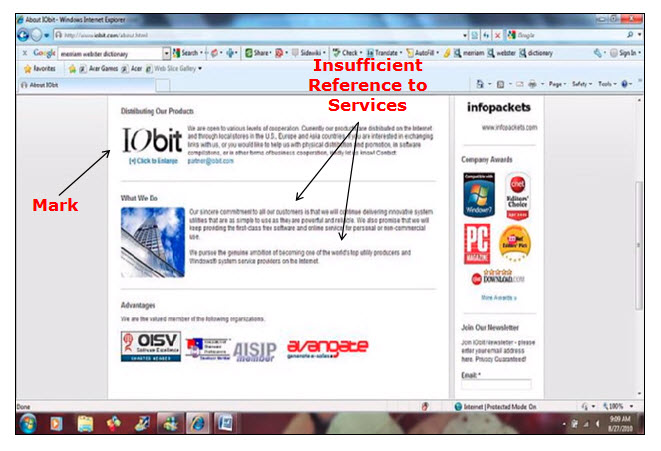
Services: Computer programming; Computer software design; Conversion of data or documents from physical to electronic media; Data conversion of computer programs and data, not physical conversion; Duplication of computer programs; Hosting of web sites; Installation of computer software; Maintenance of computer software; Research and development for new products for others; Research and development of computer software; Updating and maintenance of computer software, in Class 42.![]()
Analysis:
- Specimen is a "screenshot from applicant’s website."
- The Board found the following statements were vague and did not sufficiently reference the services:
- "Our sincere commitment to all our customers is that we will continue delivering innovative system utilities that are as simple to use as they are powerful and reliable. We also promise that we will keep providing the first-class free software and online service, for personal or non-commercial use."
- "We pursue the genuine ambition of becoming one of the world's top utility producers and Windows system service providers on the Internet."
- It is unclear whether the reference to "online service" is to a separate service or part of the free software goods. The textual reference to becoming a top utility producer and Windows system service provider is not sufficient to indicate being a provider of the identified services.
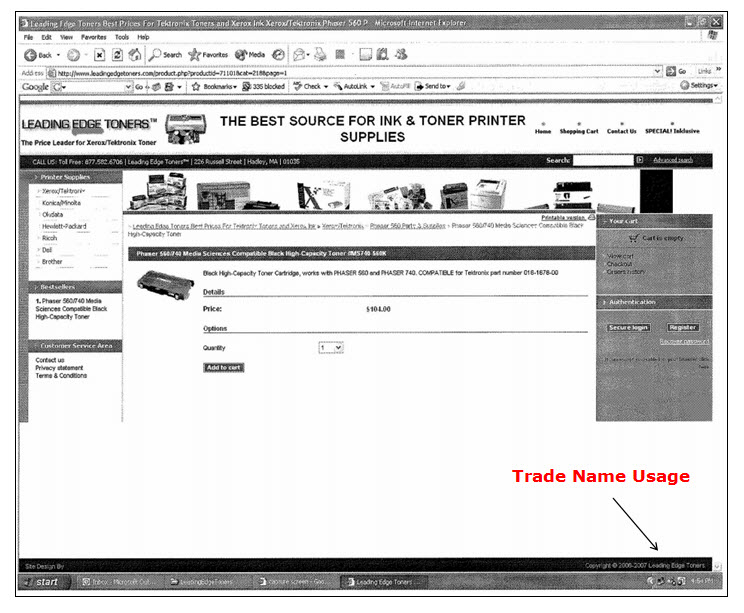
Goods: Numerous goods including toner; toner cartridges, in Class 2; components for laser toner cartridges; and printer parts, in Class 9; and Ink sticks, in Class 16. ![]()
Analysis:
- Specimen is described as a "web page."
- Mark is displayed in several places, including at the bottom right corner next to the copyright notice.
- The Board noted that "where the mark is used with the copyright notice . . ., applicant assumed ‘without admitting’ that the use was solely as a trade name."
- While the specimen is not acceptable for the identified goods, had the mark been used in connection with retail store or distributorship services, the specimen would likely have been acceptable due to the placement of the mark on the upper left corner of the webpage where service marks normally appear.